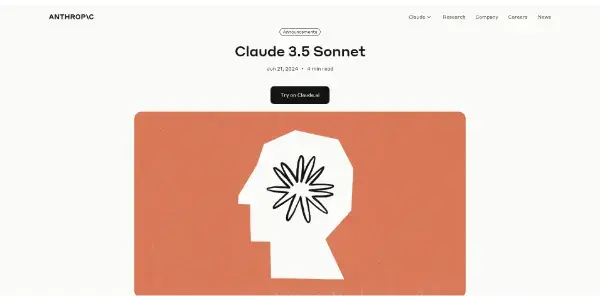Claude 3.5 Sonnet

An advanced LLM model designed by Anthropic that outperforms its competitors in reasoning, coding and image analysis. Increased performance, doubled speed
Claude 3.5 Sonnet: A Powerful and Versatile LLM
Claude 3.5 Sonnet, developed by Anthropic, represents a significant advancement in large language models (LLMs). This freemium model distinguishes itself through superior performance in reasoning, coding, and image analysis, boasting improvements over its predecessors in both speed and capability. This article delves into the capabilities, applications, and comparative advantages of Claude 3.5 Sonnet.
What Claude 3.5 Sonnet Does
Claude 3.5 Sonnet is a sophisticated LLM designed to understand and generate human-like text. Unlike simpler chatbots, it possesses advanced reasoning capabilities, allowing it to tackle complex tasks requiring logical deduction and problem-solving. Its strengths extend beyond text processing; it excels at code generation and interpretation, and it can even process and analyze visual information (though the specific image analysis capabilities may require further clarification from Anthropic). In essence, Claude 3.5 Sonnet offers a multi-faceted approach to natural language processing, making it a versatile tool across a range of applications.
Main Features and Benefits
- Enhanced Reasoning Capabilities: Claude 3.5 Sonnet demonstrates superior performance in complex reasoning tasks compared to other LLMs. This translates to more accurate and insightful responses to intricate questions and problems.
- Improved Code Generation and Analysis: The model's proficiency in coding makes it an invaluable asset for developers, assisting in code generation, debugging, and understanding complex code structures.
- Advanced Image Analysis (Requires Clarification): While the extent of its image analysis capabilities needs further specification, the claim of improved performance suggests potentially powerful applications in image captioning, object recognition, and visual question answering.
- Doubled Speed: Anthropic has emphasized a significant speed improvement, making interactions with the model significantly faster and more efficient.
- Increased Performance: Across the board, Claude 3.5 Sonnet shows demonstrably better performance in benchmark tests, reflecting its superior architecture and training data.
Use Cases and Applications
The versatility of Claude 3.5 Sonnet opens doors to a wide array of practical applications:
- Software Development: Assisting developers with code generation, debugging, and documentation.
- Data Analysis: Processing and interpreting large datasets, identifying trends, and generating insights.
- Customer Service: Providing automated customer support through natural and intelligent conversations.
- Content Creation: Generating creative text formats, such as articles, summaries, and scripts.
- Education: Serving as an interactive learning tool, providing explanations and answering complex questions.
- Research: Assisting researchers in literature reviews, data analysis, and hypothesis generation.
Comparison to Similar Tools
While a detailed comparison requires benchmarking against specific competitors (e.g., GPT-4, PaLM 2), Claude 3.5 Sonnet's advertised improvements in reasoning, coding, and speed suggest a competitive edge. Direct head-to-head comparisons are needed to definitively establish its superiority, but Anthropic's claims point towards a powerful and efficient LLM. Key differentiators likely include Anthropic's specific training methodology and focus on safety and helpfulness.
Pricing Information
Claude 3.5 Sonnet operates on a freemium model. This means that basic access and usage are free, with potentially higher usage tiers or advanced features available through a paid subscription. Specific pricing details would need to be obtained directly from Anthropic.
Conclusion
Claude 3.5 Sonnet represents a notable step forward in LLM technology. Its enhanced reasoning, coding capabilities, and improved speed make it a valuable tool across a range of industries and applications. While further details on specific image processing capabilities and detailed pricing are needed, the initial indications suggest a powerful and versatile AI assistant with the potential to significantly impact various sectors.